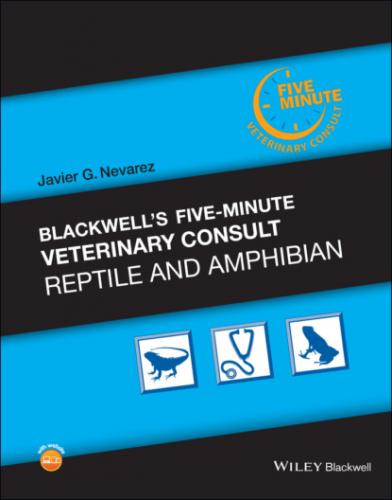PATIENT MONITORING
Repeat fecal examination at monthly intervals.
EXPECTED COURSE AND PROGNOSIS
Treatment may have variable efficacy as many protozoa are resistant to a range of anti-coccidial medication.
Prognosis is good to guarded and is determined primarily by the state of the animal at initial presentation and the presence or absence of concurrent disease.
COMMENTS
N/A
ZOONOTIC POTENTIAL
N/A
SYNONYMS
N/A
ABBREVIATIONS
K2Cr2O7 = potassium dichromate
PCR = polymerase chain reaction
PO = per os
Suggested Reading
1 Gibbons PM. Advances in reptile clinical therapeutics. J Exot Pet Med 2014;23(1):21–38.
2 Jacobson ER. Parasites and Parasitic Diseases of Reptiles. In: Jacobson ER, ed. Infectious Diseases and Pathology of Reptiles: Color Atlas and Text. Boca Raton, FL: CRC Press; 2007:571–665.
3 Kim DY, Mitchell MA, Bauer RW, et al. An outbreak of adenoviral infection in inland bearded dragons (Pogona vitticeps) coinfected with Dependovirus and coccidial protozoa (Isospora sp.). J Vet Diagn Invest 2002;14:332–334.
4 Scullion FT, Scullion MG. Gastrointestinal protozoal diseases in reptiles. J Exot Pet Med 2009;18(4):266–278.
5 Walden M, Mitchell MA. Evaluation of three treatment modalities against Isospora amphiboluri in inland bearded dragons (Pogona vitticeps). J Exot Pet Med 2012;21(3):213–218.
6 Wolf D, Vrhovec MG, Failing K, et al. Diagnosis of gastrointestinal parasites in reptiles: comparison of two coprological methods. Acta Vet Scand 2014;56:1–13.
Author T. Franciscus Scheelings, BVSc, MVSc, PhD, MANCVSc (Wildlife Health), DECZM (Herpetology)
Leukemia
DEFINITION/OVERVIEW
Leukemia is a neoplasia of the white blood cells, which starts in the bone marrow.
ETIOLOGY/PATHOPHYSIOLOGY
No confirmed etiology has been proved for any of the leukemia cases described in chelonians, including viral etiology.
Leukemias are classified as myeloid or lymphoid, depending upon the neoplastic blood cell.
It is generally accepted, based on previously reported cytochemical staining characteristics, that reptilian granulocytes, monocytes, and azurophils are from the myeloid cell lineage, whereas reptilian lymphocytes are from the lymphoid cell lineage.
Leukemias are commonly graded as acute or chronic depending on the number of blast cells in peripheral circulation.
Blast cells predominate in acute leukemia, whereas mature forms predominate in chronic onset leukemia, with less than 30% of the peripheral leukocytes being blast cells.
Acute leukemias are rapidly fatal in untreated patients.
SIGNALMENT/HISTORY
Leukemia in chelonians has been reported in both adult and immature turtles.
CLINICAL PRESENTATION
Anorexia and lethargy are frequently reported.
Weight loss is common in chronic leukemia.
RISK FACTORS
Husbandry
N/A
Others
N/A
DIFFERENTIAL DIAGNOSIS
Multiple myeloma or plasma cell myeloma.
Monoclonal gammopathy
DIAGNOSTICS
Hemogram: a marked leukocytosis characterized by lymphocytosis/monocytosis (depending upon the type of leukemia) can be observed.
Cytological evaluation of blood smears and/or bone marrow biopsy (because of the extensive bony trabecular network, conventional bone marrow aspirates in chelonians have low cell yield; bone marrow
may be collected from the gular projection of the plastron or the bridge of the plastron and carapace) (Silverstone et al, 2007).
Necropsy and subsequent histopathology
Cytochemical and immunocytochemical stains to confirm cell lineage.
Cytochemical staining can include α-naphthyl butyrate esterase, chloroacetate esterase, Sudan black B, and alkaline phosphatase to distinguish myeloid or lymphoid origin; it is important to study comparison samples from both clinically healthy and affected animals of the same species because of the paucity of cytochemical characterization of blood cells for most reptiles. CD3 antibody identifies T-cell lymphocytes and Pax-5 and BLA36 antibodies identify B-cell lymphocytes (Silverstone et al, 2007; Bezjian et al, 2013). L1-calprotectin antibody has been used to identify myeloid cells in lizards.
Transmission electron microscopy can be attempted to determine histogenesis and to identify viral particles.
PATHOLOGICAL FINDINGS
Cytological evaluation of blood smears and/or bone marrow aspirates can reveal abnormal cell morphology of the neoplastic cells, abnormal nuclear to cytoplasm ratio, and anisokaryosis; mitotic figures are frequently detected.
Histopathologic examination of tissue samples can reveal infiltration of neoplastic cells in several organs and occasional mitotic figures.
APPROPRIATE HEALTH CARE
N/A
NUTRITIONAL SUPPORT
An esophagostomy tube should be considered in anorexic animals or
